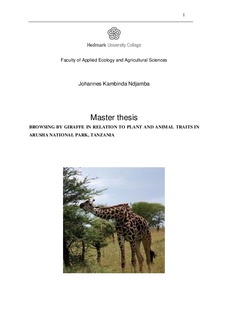| dc.description.abstract | This paper investigates the feeding ecology of mature browsing giraffes during the wet season in Arusha National Park in Tanzania. I looked at different factors (predictor variables) affecting giraffe’s browsing time on a plant, biting rate, bite size, and intake rate (response variables). Predictor variable ranged from plant traits (habitat, spinescence, tree height) to the giraffe’s traits and behaviours (sex, browsing height, bite diameter, biting rate). The study reveals that only sex and spinescence was significantly influencing giraffes browsing patterns. Bulls were found to spend more time on a plant than cows, which switched plants frequently. This suggests that females are interested in forage quality rather than forage quantity, as are male giraffes. Biting rate was higher on armed plants than on unarmed plants. Furthermore, this was related to bite size, which was smaller for armed plants than for unarmed. This suggested that biting rate was higher at small bites than at large bites. Females were found to have larger bite size than male giraffes. The same pattern was observed for intake rate that was higher for females than for males. Intake rate was also high for the unarmed plants. This suggests that the bigger the bite taken the higher the intake rate for the giraffes in Arusha National Park. | nb_NO |
